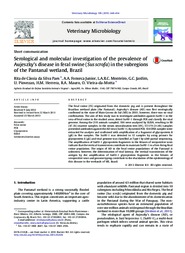Serological and molecular investigation of the prevalence of Aujeszky's disease in feral swine (Sus scrofa) in the subregions of the Pantanal wetland, Brazil.
Serological and molecular investigation of the prevalence of Aujeszky's disease in feral swine (Sus scrofa) in the subregions of the Pantanal wetland, Brazil.
Autoria: PAES, R. de C. da S.; FONSECA JUNIOR, A. A.; MONTEIRO, L. A. R. C.; JARDIM, G. C.; PIOVEZAN, U.; HERRERA, H. M.; MAURO, R. A.; VIEIRA-da-MOTTA, O.
Resumo: The feral swine (FS) originated from the domestic pig and is present throughout the Brazilian wetland plain (the Pantanal). Aujeszky?s disease (AD) was first serologically confirmed in the state of Mato Grosso do Sul (MS) in 2001; however, there was no viral confirmation. The aim of this study was to investigate antibodies against-SuHV-1 in the sera of feral swine in the studied areas, detect SuHV-1 through PCR and classify the viral genome. Among the 218 animals sampled, 186 were analyzed by ELISA, resulting in 88 (47.3%) reactive samples. In the serum neutralization test (SN), 57/179 (31.8%) samples presented antibodies against the AD virus (SuHV-1). By nested PCR, 104 DNA samples were extracted for analysis and confirmed with amplification of a fragment of glycoprotein B (gB) in five samples. The SuHV-1 was detected in 12 samples by using primers for glycoprotein E (gE) and viral genome was classified as Type I by ul44 partial sequencing. The amplification of SuHV-1 glycoprotein fragments in the fetuses of seropositive sows indicate that the vertical transmission contribute to maintain SuHV-1 in a free-living feral swine population. The origin of AD in the feral swine populations of the Pantanal is unknown, however, the determination of viral latency, the vertical transmission of the antigen by the amplification of SuHV-1 glycoprotein fragments in the fetuses of seropositive sows and genome typing contribute to the elucidation of the epidemiology of this disease in the wetlands of MS, Brazil.
Ano de publicação: 2013
Tipo de publicação: Artigo de periódico
Unidade: Embrapa Pantanal
Palavras-chave: Elisa, Feral swine, Glycoprotein, PCR, Seroneutralization assay
Observações
1 - Por padrão são exibidas publicações dos últimos 20 anos. Para encontrar publicações mais antigas, configure o filtro ano de publicação, colocando o ano a partir do qual você deseja encontrar publicações. O filtro está na coluna da esquerda na busca acima.
2 - Para ler algumas publicações da Embrapa (apenas as que estão em formato ePub), é necessário ter, no celular ou computador, um desses softwares gratuitos. Sistemas Android: Google Play Livros; IOS: iBooks; Windows e Linux: software Calibre.
Acesse outras publicações
Acesse a Base de Dados da Pesquisa Agropecuária (BDPA) para consultar o acervo completo das bibliotecas da Embrapa.

